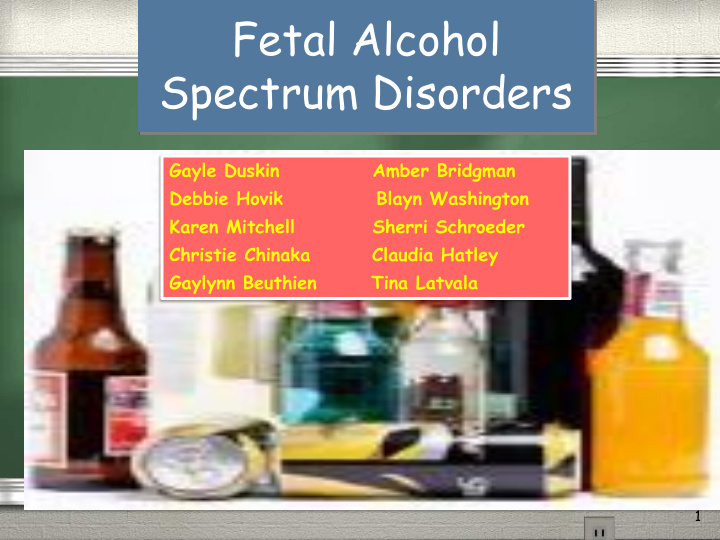



Fetal Alcohol Spectrum Disorders Gayle Duskin Amber Bridgman Debbie Hovik Blayn Washington Karen Mitchell Sherri Schroeder Christie Chinaka Claudia Hatley Gaylynn Beuthien Tina Latvala 1
Definition 1 . Fetal Alcohol Syndrome and Fetal Alcohol Effects Disorder: ( FASD) are umbrella terms describing the effects that can occur in an fetus whose mother drank alcohol during pregnancy. 2.These effects may include physical, mental, behavioral, and/or learning disabilities with possible lifelong implications for problems in many areas of life: work, school, and social relations. (pg vii) 2
Diagnosis Identification of FASD is complicated. Early intervention is best! Children are generally seen by a pediatrician, then referred to a Dysmorphologist for diagnosis. Practitioners and nurses who interviewed parents state “parents are very poor historians” due to parental reluctance to admit to either drug/alcohol use or the amount and frequency of use” (pg 10). The effects vary due to genetic precursors. For example: Gene variations of gene ADH2, as predictors of FASD. ... Studies have shown that the ADH2*2 allele was found to be more common in mothers who did not have offspring with FASD, suggesting the ADH2*2 may contribute protection against FASD.” (pg. 11) Paternal drinking and or exposure to chemicals and or toxins have been linked to low birth weight, further studies need to be done to indicate fathers contribution. 3
Main Idea Outcomes of alcohol-related disorders occur along a continuum spectrum from mild to severe. Not all students with alcohol related disorders have the physical characteristics (facial morphology: small head and eyes, thin upper lip). Leading cause of MR in Western Regions: 1 in 100 students born are affected by FASD Many students with FASD have deficits in social communication and do not know how to use language to negotiate tasks, demands, and social interactions. Even though they are often seen as talkative and chatty. Case Study: Example 4
Recommendations Eight Magic Keys: Developing Successful Intervention for Students With FAS 1. Concrete 2. Consistency 3. Repetition 4. Routine 5. Simplicity 6. Specific 7. Structure 8. Supervision 5
Recommendations Continued . . . 1 . Be Concrete – 2. Be Consistent – Use concrete terms Transition by using planned prompts Don’t use idioms, etc. Coordinate materials w/teachers Low social-emotional understanding Pre-teach new material as home-work Have things repeated due to Low Use key words and phrases Verbal acquisition & recall of text Generalize themes for connections Assume they are younger when providing assistance, & giving Ask for feedback often to check for instructions, etc. understanding 6
continued 3. Repetition – Students with FAS have chronic short-term memory problems They forget things they 4. Routine – want remember Be consistent stick with stable They forget what has been routines that don’t change learned Create known expectations to In order for something to decrease anxiety enables FAS make it to long term kids to learn. memory, it may simply need to be re-taught and re- taught. 7
continued 5. Simplicity - Remember to . . . Keep it Short and Sweet (KISS method). Students with FAS are easily over-stimulated, leading to "shutdown" at which point no more information can be assimilated. 6. Specific - Say exactly what you mean. FAS kids have a hard with abstractions, generalization, and not being able to "fill in the blanks“. Tell them step by step what to do, developing appropriate habit patterns. 8
Continued 7. Structure – HINT : Structure is the "glue“ that makes the When a situation with a student with world make sense for a student with FAS. FAS is confusing and the intervention is If this glue is taken away, the walls fall not working, then: down! A student with FAS achieves and is successful because their world provides Do this!!!! the structure as a permanent foundation. Stop Action! 8. Supervision – Observe Because of their cognitive challenges, students with FAS bring a Listen to find out where e/she is stuck naiveté to daily life situations. They need constant supervision, as with much younger Ask: What is hard,& what will help? children, to develop habit patterns of appropriate behavior. 9
Resources Dybdahl, C., & Ryan, S. (Spring, 2009). Inclusion for students with fetal alcohol syndrome: classroom teachers talk about practice. Preventing School Failure , 53 (3), 185-196. Retrieved July 13, 2009, from Academic Search Premier database./ Edmonds, Kelly and Crichton, Susan (2008). Finding Ways to Teach to Students with FASD: A Research Study. International Journal of Special Education 23(1). Evensen, D. Lutke, J. ( 1997). 8 Magic keys: developing successful interventions for students with FAS. Fasalaska Project FACTS (Fetal Alcohol Consultation and Training Services). Retrieved July 14, 2009, from http://www.fasdcenter.samhsa.gov/documents/EightMagicKeys.pdf. Green, J (2007). Fetal alcohol spectrum disorders: Understanding the effects of prenatal alcohol exposure and supporting students. Journal of School Health , 77 , 103-108. Harpur, L. (2001, Fall2001). FASD teens in the Classroom: basic strategies. Guidance & Counseling , 17 (1), 24. Retrieved July 13, 2009, from Academic Search Premier database. Miller, D. (2006). Students with Fetal Alcohol Syndrome: Updating OurKnowledge, Improving Their Programs. Teaching Exceptional Children, 38(#4), 12-18. Olson, H., Jirikowic, T., Kartin, D., & Astley, S. (2007, April). Responding to the challenge of early intervention for fetal alcohol spectrum disorders. Infants & Young Children: An Interdisciplinary Journal of Special Care Practices , 20 (2), 172-189. Retrieved July 13, 2009, from Academic Search Premier database. Soby, J. (2006). Prenatal Exposure to Drugs/Alcohol. Springfield: Charles C Thomas 10
Recommend
More recommend